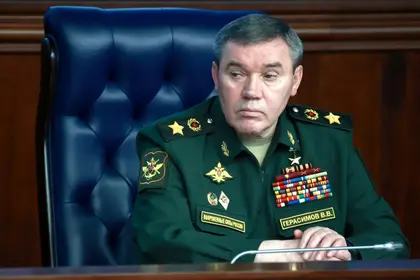The military issues website Defense Blog reported that during a briefing for foreign military attachés in Moscow on Wednesday, General Valery Gerasimov, Chief of the Russian General Staff, said that during the latest NATO Steadfast Defender exercise deployed a new missile system on the Danish island of Bornholm which he said was called “Dark Typhon.”
However, there is no weapons system of that name in the inventory of any of NATO’s 32 member nations. It seems likely that Gerasimov, or whoever prepared his briefing notes, inadvertently merged the names of two separate US systems – the US Army’s long-range “Dark Eagle” hypersonic long-range missile and the “Typhon” mobile Strategic Mid-range Fires (SMRF) missile launch system.
Dark Eagle, more correctly the US Long-Range Hypersonic Weapon (LRHW), is an intermediate-range surface-to-surface boost-glide hypersonic weapon still under development and had its first successful test firing at Cape Canaveral on Dec. 12 – it is not yet ready to be deployed anywhere.
The Typhon (SMRF) US Army mobile, land-based missile system is used to launch SM-6 missiles with a range of around 450 kilometers (280 miles) and Tomahawk missiles with a range of up to 2,500 kilometers (1,550 miles). The system was designed to target Chinese military facilities, including its anti-cruise ballistic missiles (ACBMS).

Trade Wars, Culture Wars, and Anti-Immigration: Trump’s Big Promises
It has been temporarily deployed to the Philippines since April 2024.
It is most unlikely that either of the systems were used on Steadfast Defender which is made up of several stand-alone military maneuvers held throughout the NATO European area between January and May.
Several military commentators picked up on Gerasimov’s misstep as the latest in a series of publicly made blunders that, while not that serious on its own, continues to cast doubt on the competence of Russia’s top leadership. Even President Vladimir Putin seems not to be immune.
Putin’s conflicting statements surrounding Russia’s new medium-range ballistic missile (MRBM), the RS-26 “Oreshnik,” has raised questions as to whether they were intentionally meant as disinformation or another example of poor briefing.
On Nov. 21, Russia reportedly launched an RS-26 missile against the Ukrainian city of Dnipro which Putin claimed was carried out using the Oreshnik MRBM, the first public announcement of the use of the system. The limited levels of damage caused suggested that the six separate warheads delivered by the system were inert and the attack was a “live trial” of the weapon.
A week later at the November Collective Security Treaty Organization (CSTO) summit in Astana, Kazakhstan, he sang the praises of the system while insisting it wasn’t “a weapon of mass destruction,” he said the “… the use of these missiles – several in one strike - the power… would be comparable to the use of nuclear weapons.” he then went on to say that the “mass production of the Oreshnik MRBM has already started.”
However, on Dec. 16 while addressing a meeting of the Russian Defense Ministry Board Putin claimed that production of the missile would commence soon, in contradiction of his earlier remarks. It was not clear of the reasons why this was intentional or, as one or two analysts suggest, production difficulties arose in the two or three weeks between the statements. Either way, they argue, it doesn’t reflect well on Moscow’s leadership, especially as Putin had been portraying the Oreshnik as an example of yet another Russian advanced and reliable game-changing weapon.
Defense Blog also highlights how many of the statements from Russia’s Ministry of Defense of military successes during the so-called “special military operation” don’t stack up. As an example, it points out that Russian officials have claimed to have shot down more Ukrainian aircraft than the whole of NATO’s European air forces.
The journal argues that even if such statements were intended as misinformation, a favorite ploy of Russian messaging, the frequency of such nonsensical errors and internal contradictions continues to raise questions about the quality of the Kremlin’s military leadership.
It says these gaffes indicate incredible levels of incompetence and mismanagement at the very top and wonders if this growing perception of top-level disarray will ultimately undermine the credibility of the leadership domestically and internationally.
You can also highlight the text and press Ctrl + Enter










